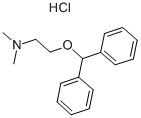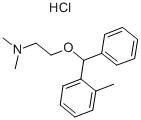Diphenhydramine Hydrochloride
Synonym(s):N-(2-Diphenylmethoxyethyl)-N,N-dimethylamine hydrochloride;2-Diphenylmethoxy-N,N-dimethylethylamine hydrochloride;DP;DPH
- CAS NO.:147-24-0
- Empirical Formula: C17H22ClNO
- Molecular Weight: 291.82
- MDL number: MFCD00012479
- EINECS: 205-687-2
- SAFETY DATA SHEET (SDS)
- Update Date: 2025-12-17 09:50:05

What is Diphenhydramine Hydrochloride?
Description
Diphenhydramine is most commonly used as a first-generation antihistamine and is globally marketed in various brand formulations (Benadryl®, Unisom®, Tylenol®, Zzzquil®). It competitively blocks H1 receptors, thereby preventing the actions of histamine on bronchial smooth muscle, capillaries, and gastrointestinal (GI) smooth muscle. This prevents histamine-induced bronchoconstriction, vasodilation, increased capillary permeability, and GI smooth muscle spasms. Diphenhydramine exhibits anti-tussive, antiemetic, sedative, anti-allergic, and anticholinergic activities.
Chemical properties
White or almost white, crystalline powder. odorless and has a bitter, numbing taste. soluble in water and in alcohol.
Originator
Benadryl,Parke Davis,US,1946
The Uses of Diphenhydramine Hydrochloride
Diphenhydramine is a H1-histamine receptor antagonist with anticholinergic (drying) and sedative side effects. It is categorized as an antihistaminic; sedative, hypnotic, treatment of allergic. It is used to treat allergy and cold symptoms such as sneezing, runny nose, watery eyes, urticaria (hives), skin rash, and pruritus (itchy skin).
What are the applications of Application
Diphenhydramine hydrochloride is a histamine H1-receptor antagonist
Definition
ChEBI: Diphenhydramine Hydrochloride is the hydrochloride salt form of diphenhydramine, an ethanolamine and first-generation histamine antagonist with anti-allergic activity.
What are the applications of Application
Diphenhydramine hydrochloride is used as an antihistamine and for its antieholinergie (drying) and sedative effects; for allergic conjunctivitis due to foods; for mild, uncomplicated allergic skin manifestations of urticaria and angioedema; for amelioration of allergic reactions to blood or plasma; for dermatographism; in therapy for anaphylaetie reactions adjunctive to epinephrine and other standard measures after the acute manifestations have been controlled; for active and prophylactie treatment of motion sickness; for parkinsonism; an antiemetic; has local anesthetic properties; in preparations for the relief of cough; in the prevention and treatment of radiation sickness, nausea and vomiting; for treatment of allergie cheilitis and stomatitis.
Preparation
Diphenhydramine Hydrochloride synthesis is a four-step sequence starting with a Grignard reaction. 
Synthesis of Diphenhydramine Hydrochloride 6.
A) modified synthetic route to diphenhydramine hydrochloride.
B) Sequence of unit operations required for the synthesis. The dotted boxes denote the four stages of the synthesis. DMAE: dimethylaminoethanol.
Organic synthesis in a modular robotic system driven by a chemical programming language
brand name
Benadryl (Parke-Davis).
Therapeutic Function
Antihistaminic
General Description
Diphenhydramine hydrochloride(Benadryl), is an oily, lipid-soluble free base available as the bitter-tasting hydrochloride salt, which is a stable, White or almost-white crystalline powder. Odorless with a bitter numbing taste. soluble in water (1:1), alcohol (1:2) and chloroform (1:2). The salt has a pKa value of 9, and a 1% aqueous solution has a pH of about 5.
Air & Water Reactions
Water soluble. Aqueous solutions are acidic.
Reactivity Profile
N-(2-Diphenylmethoxyethyl)-N,N-dimethylamine hydrochloride gives acidic solutions in water. Neutralizes bases. May react with strong oxidizing and strong reducing agents. May catalyze organic reactions. Slowly darkens on exposure to light.
Health Hazard
Potentially. If taken in large quantities, diphenhydramine can cause severe agitation and confusion, fever, skin flushing, problems with vision, dry mouth, dry eyes, and inability to sweat. Overdoses can lead to high heart rates, abnormal heart rhythms, seizures, and death.
If given to elderly patients, diphenhydramine can cause confusion and agitation. Because of this, diphenhydramine is not recommended in elderly patients for insomnia or treatment for the common cold; though it should still be given in cases of allergic reaction.
Biological Activity
Diphenhydramine (DPH) is a first generation antihistamine that is a potent antagonist of the histamine H1 receptor (Ki = 11.7 nM using human recombinant receptors). DPH readily crosses the blood-brain barrier and produces diverse cognitive and psychomotor effects. DPH also antagonizes muscarinic cholinergic receptors (Kis = 100 to 260 nM for M1-M5), increasing the range of central nervous system effects and applications.
Contact allergens
This antihistaminic drug with sedative properties is mainly sold over the counter. It can be used both topically (treatment of pruritis) and orally for its antiallergic, antiemetic, sedative, and anticough properties. Allergic or photoallergic contact dermatitis and fixeddrug eruption seem to be rare.
Biochem/physiol Actions
Diphenhydramine hydrochloride (DPH) is an antihistaminic agent that relieves symptoms of hypersensitive reactions. It exhibits antimuscarinic and marked sedative effects. DPH is also used to prevent nausea, vomiting and vertigo of various causes. In addition, it acts as a potential therapeutic for insomnia.
Safety Profile
Poison by ingestion, subcutaneous, intravenous, and intraperitoneal routes. Human systemic effects by ingestion or skin contact: arrhythmias, ataxia, blood pressure elevation, convulsions, distorted perceptions, eye effects, and hallucinations. Experimental teratogenic and reproductive effects. Questionable carcinogen with experimental tumorigenic data. When heated to decomposition it emits very toxic fumes of NO, and HCl. See also ESTERS and ETHERS.
Veterinary Drugs and Treatments
In veterinary medicine, diphenhydramine is used principally for its antihistaminic effects, but also for other pharmacologic actions. Its sedative effects can be of benefit in treating the agitation (pruritus, etc.) associated with allergic responses. It has also been used for treatment and prevention of motion sickness and as an antiemetic in small animals. It has been suggested for use as adjunctive treatment of aseptic laminitis in cattle and it may be useful as an adjunctive treatment for feline pancreatitis. For other suggested uses, refer to the Dosage section below.
Storage
Desiccate at RT
Properties of Diphenhydramine Hydrochloride
| Melting point: | 168-172 °C |
| Boiling point: | 163-167 °C(Press: 3 Torr) |
| Density | 1.0489 (rough estimate) |
| refractive index | 1.5800 (estimate) |
| Flash point: | 9℃ |
| storage temp. | 2-8°C |
| solubility | Very soluble in water, freely soluble in alcohol. |
| form | Crystalline Powder or Adhering Crystals |
| color | White |
| PH | pH(100g/L, 25℃) 4.0~5.5 |
| Water Solubility | 1000 g/L |
| Sensitive | Light Sensitive |
| Merck | 14,3309 |
| Stability: | Stable, but slowly darkens upon exposure to light. Incompatible with strong oxidizing agents. |
| CAS DataBase Reference | 147-24-0(CAS DataBase Reference) |
| NIST Chemistry Reference | diphenhydramine hydrochloride(147-24-0) |
| EPA Substance Registry System | Diphenhydramine hydrochloride (147-24-0) |
Safety information for Diphenhydramine Hydrochloride
| Signal word | Warning |
| Pictogram(s) |
 Exclamation Mark Irritant GHS07 |
| GHS Hazard Statements |
H302:Acute toxicity,oral |
Computed Descriptors for Diphenhydramine Hydrochloride
| InChIKey | PCHPORCSPXIHLZ-UHFFFAOYSA-N |
Diphenhydramine Hydrochloride manufacturer
Attar Global
Remedy Labs
Imex Overseas
Bazayan & Co.
New Products
4,4-Difluoropiperidine hydrochloride tert-butyl 9-methoxy-3-azaspiro[5.5]undecane-3-carboxylate Indole Methyl Resin N-Isopropylurea N,N-Dicyclohexylcarbodiimide(DCC) MELDRUMS ACID 5-METHYLISOXAZOLE-4-CARBOXYLIC ACID Magnessium Bis glycinate Zinc ascorbate 1-bromo-2-butyne 2-acetamidophenol 9(10H)-anthracenone Erythrosin B, 4-Piperidinopiperidine 2-((4-morpholinophenylamino) (methylthio) methylene) malononitrile 2,4-dihydroxybenzaldehyde 3-(4-morpholinophenylamino)-5-amino-1H-pyrazole-4-carbonitrile Methyl 2-methylquinoline-6-carboxylate 2,6-dichloro-4-nitropyridine 4-Bromo-2-chlorobenzonitrile 2-(benzylamino)acetic acid hydrochloride 4-(tert-Butoxycarbonylamino)but- 2-ynoic acid 3,4-dihydro-2H-benzo[b][1,4]dioxepine 1-Phenyl-1-cycloprppanecarboxylicacidRelated products of tetrahydrofuran





![3-Methyl-7-phenyl-6-oxa-3-azabicyclo[6.4.0]dodeca-8,10,12-triene](https://img.chemicalbook.in/CAS/GIF/13669-70-0.gif)


You may like
-
 DIPHENHYDRAMINE HCL 99%View Details
DIPHENHYDRAMINE HCL 99%View Details -
 Diphenhydramine hydrochloride 98%View Details
Diphenhydramine hydrochloride 98%View Details
147-24-0 -
 Diphenhydramine hydrochloride 147-24-0 99%View Details
Diphenhydramine hydrochloride 147-24-0 99%View Details
147-24-0 -
 Diphenhydramine Hcl 99%View Details
Diphenhydramine Hcl 99%View Details -
 Diphenhydramine Hydrochloride CAS 147-24-0View Details
Diphenhydramine Hydrochloride CAS 147-24-0View Details
147-24-0 -
 Diphenhydramine hydrochloride CAS 147-24-0View Details
Diphenhydramine hydrochloride CAS 147-24-0View Details
147-24-0 -
 Diphenhydramine hydrochloride >98% (HPLC) CAS 147-24-0View Details
Diphenhydramine hydrochloride >98% (HPLC) CAS 147-24-0View Details
147-24-0 -
 Diphenhydramine Hcl API, 98%View Details
Diphenhydramine Hcl API, 98%View Details
147-24-0
